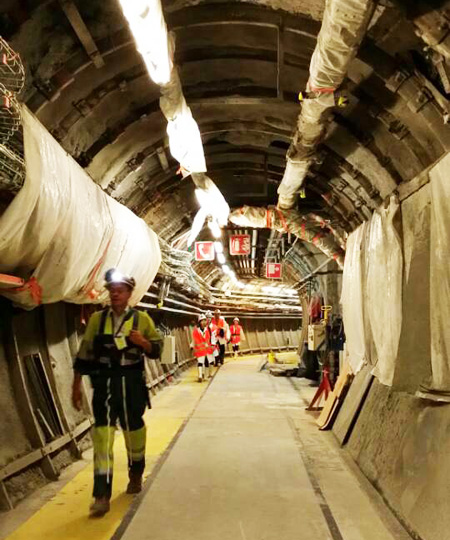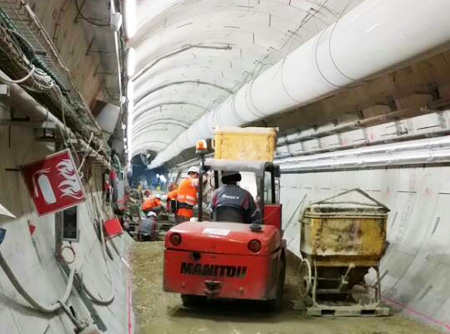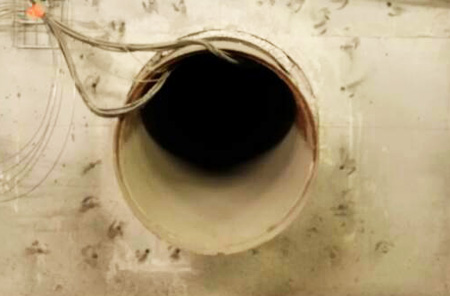Press Release

A French nuclear engineer walks through an underground corridor in Bure
to test the safety of burying high-grade radioactive waste deep underground.
Temporary storage will start running out in 2016
BURE, France — Roughly 500 meters under the ground of this sparsely populated town — once the home to several military weapon manufacturers after World War II — the French government is carrying out a groundbreaking experiment, which Korea is closely following in order to learn how to cure its intensifying headache:spent nuclear fuel.
The experiment examines whether burying high-grade radioactive waste deep underground is the best approach for its permanent disposal.
Scientists from ANDRA, the French national radioactive waste management agency, have conducted a variety of experiments for many years in this town about 300 kilometers west of Paris to verify this.
"Our foremost mission is protecting people and the environment from hazardous (nuclear) waste over a very long time," Alain Rolland, an ANDRA deputy director, told Korean reporters who visited the underground testing site last week. "This also aims to avoid placing the burden of dealing with radioactive waste on future generations."
Spent nuclear fuel, which is of no use commercially, continues to generate life-threatening levels of heat and radiation for thousands of years.
The veteran nuclear engineer underscored the underground disposal's effectiveness for heat and radiation control, saying "all countries" with nuclear power plants have adopted "deep geological disposal" as the final management solution.
This is one of the options that the Korean government has in mind. Asia's fourth-largest economy has 23 nuclear power plants that produce about 750 tons of spent nuclear fuel annually.
Undeterred by Japan's Fukushima disaster in 2011 and a slew of safety failures linked to domestic nuclear plants last year, Korea plans to boost nuclear power to 40 percent of its energy needs with the addition of 11 reactors by 2024.
More than 13,250 tons of spent nuclear fuel has been created since the country's first nuclear power plant went operational in 1978.

All of them are being cooled down at temporary storage facilities within the plants' compounds.
Storage at the Gori Nuclear Power Plant in Busan — Korea's oldest nuclear power plant — will be fully packed with spent nuclear fuel rods by 2016. Saturation will be reached at the Wolsong Nuclear Power Plant in 2017 and at the Uljin Nuclear Power Plant in 2018. It is only a matter of time before other plants face the same problem.
To tackle this problem, the Seoul government is moving to build a permanent storage facility for spent nuclear fuel rods by 2050. This means that Korea still needs to have interim storage facilities — or advanced management technologies — to keep the high-level radioactive waste under control between 2016 and 2050.
The problem is that with the first saturation only two years away, Korea remains largely unprepared.
"Frankly speaking, nothing has been done, including selecting location (of interim storage sites) and developing technologies we need," said Cho Seong-kyung, an engineering professor at Myongji University, who has studied the issue for years.
"There are even no basic guidelines on how to push the project forward systematically."
She lamented the government's lack of attention to the problem. "Though belated, we should begin with setting a concrete and long-term direction (to solve this)," Cho said.
The Korea Atomic Energy Research Institute is responsible for carrying out related studies and research, but has made little progress due to chronic shortages of money and manpower, according to the professor.
Against this backdrop, the Ministry of Trade, Industry and Energy launched an independent committee, called the Public Engagement Commission on Spent Nuclear Fuel Management (PECSNFM), in October. This reflects the government's increasing sense of urgency.
The commission has since sought advice from nuclear experts, activists and citizens. Based on that, it will suggest a comprehensive nuclear waste management roadmap to the ministry by the end of this year.
Its commissioner has vowed to consider all possible solutions, including reprocessing spent nuclear fuel.
Korea is strictly banned from reprocessing spent nuclear fuel under a 1973 treaty with the United States, even though this is one of the most effective ways to reduce the volume and toxic level.

This stainless pipe will be used in tests to find the best way to store spent
nuclear fuel underground permanently. / Courtesy of PECSNFM
Permanent disposal
The French testing site for underground disposal is in a virtually abandoned area, with extensive green fields stretching to the horizon and lightly travelled roads in the distance.
Only about 100 people live in the vicinity, according to Bure Mayor Antoine Gerard.
High fences with barbed wire on top surround the site. Several stone-faced security guards keep watch on visitors, reflecting the secretive nature of experiments at the facility.
Only those equipped with high-end safety gear and two-way radios were allowed into a red elevator transporting 14 visitors down to the testing facility 500 meters underground. The one-way trip took seven minutes.
Scores of cables, ventilation pipes and monitoring systems were hanging alongside the walls or ceiling of the round-shaped tunnels that stretched in various directions like a maze. For safety reasons, only a maximum of 49 people were allowed to stay at the site at one time.
"A variety of experiments are under way to make sure this site is suitable to store high-level radioactive waste permanently," an ANDRA spokesman said.
He said the facility was surrounded by hundreds of thick clay layers that form a natural shield, keeping radiation from leaking into the outer atmosphere. Based on the test results, French authorities will decide whether or not to build a permanent storage facility for spent nuclear fuel rods in Bure by 2020. If approved, the facility would begin operating in 2025.
"What we can learn from France is that this country mapped out related plans many years ago and then pushed forward slowly but surely," said Cho, who serves as PECSNFM spokeswoman.
"In contrast, there are so many loopholes in Korea. And things have been moving at a snail's pace," she said. "We should take action immediately. The deadline is coming."
Reprocessing
Reprocessing spent nuclear fuel is effectively banned under the Korea-U.S. Civil Nuclear Cooperation Agreement. Korea needs consent from the United States to reprocess spent nuclear fuel. The government demanded this during negotiations earlier this year related to extending the agreement.
However, the U.S. is unwilling to grant Korea's demand because doing so would weaken the U.S. position opposing global nuclear proliferation. A strong U.S. ally, Korea is not happy because the U.S. has previously given such consent to Japan and India — the latter of which is not even a signatory of the Treaty on the Non-Proliferation of Nuclear Weapons.
In the meantime, Korea and the U.S. continue their joint research and development (R&D) program on pyroprocessing, the technology of extracting uranium and plutonium from a mixture that can be made into nuclear fuel for commercial purposes.
Because plutonium is not separated in the process, Korea has argued that pyroprocessing will not lead to nuclear weapons being developed. The U.S., however, has not agreed to any further development beyond the R&D stage. The Korea Atomic Energy Research Institute is the global leader in pyroprocessing research.
Another disadvantage of pyroprocessing is that the nuclear fuel produced from the process cannot be used in ordinary reactors, but in fast reactors that are under development.
"The potential nonproliferation benefits of pyroprocessing over commercial aqueous processing remain contested," said a joint report released in December 2013 by the Center for International Security and Cooperation at Stanford University and Korea's East Asia Institute.
"We see potentially significant technical benefits from pyroprocessing, but do not believe that it will result in significant economic benefits until the introduction of fast reactor technologies, a process that may take an even longer time period than mastering pyroprocessing."